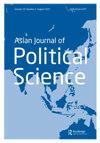从中海油到华为:证券化、中国威胁和关键基础设施
IF 1
Q3 POLITICAL SCIENCE
引用次数: 12
摘要
摘要本文运用批判性话语分析来考察中国是如何被美国建构为一个生存威胁的。具体来说,它探讨了2005年美国对中国海洋石油总公司(CNOOC)的反应如何为十年后对华为的类似反应创造了先例。它使用这些案例研究来展示中国威胁与关键基础设施安全话语之间的相互作用如何在更广泛的美国话语中成功地将中国证券化。这些研究表明,美国精英对中国进行了蓄意和长期的证券化,它们支持了证券化理论的更关键的方法,这些方法强调累积和增量方面,而不是证券化/去证券化的二元对立。对关键文本的话语分析使读者能够揭示安全问题是如何被社会建构的,对中海油和华为的话语考察说明了对国家安全的关注现在如何被运用到美国的日常政治话语中,因此中国威胁话语已成为美国观察家对中国的主要阅读。本文章由计算机程序翻译,如有差异,请以英文原文为准。
From CNOOC to Huawei: securitization, the China threat, and critical infrastructure
ABSTRACT This article uses critical discourse analysis to examine how China has been constructed as an existential threat by the United States. Specifically, it explores how US reactions to the China National Offshore Oil Corporation (CNOOC) in 2005 created precedent for similar reactions to Huawei a decade later. It uses these case studies to demonstrate how the interplay between the China threat and security discourses of critical infrastructure has worked to successfully securitize China within broader American discourse. These examinations demonstrate a deliberate and protracted securitization of China by US elites, and they support more critical approaches to securitization theory that emphasize cumulative and incremental aspects over a securitized/de-securitized binary. Discourse analysis of key texts allows the reader to uncover how security issues are socially constructed, and discursive examinations of CNOOC and Huawei illustrate how concerns about national security are now employed in everyday American political discourse so that the China Threat Discourse has become the primary reading of China by US observers.
求助全文
通过发布文献求助,成功后即可免费获取论文全文。
去求助
来源期刊

Asian Journal of Political Science
POLITICAL SCIENCE-
CiteScore
2.00
自引率
0.00%
发文量
11
期刊介绍:
Asian Journal of Political Science ( AJPS) is an international refereed journal affiliated to the Graduate School of Public Administration, Seoul National University. Published since 1993, AJPS is a leading journal on Asian politics and governance. It publishes high-quality original articles in major areas of political science, including comparative politics, political thought, international relations, public policy, and public administration, with specific reference to Asian regions and countries. AJPS aims to address some of the most contemporary political and administrative issues in Asia (especially in East, South, and Southeast Asia) at the local, national, and global levels. The journal can be of great value to academic experts, researchers, and students in the above areas of political science as well as to practical policy makers, state institutions, and international agencies.
 求助内容:
求助内容: 应助结果提醒方式:
应助结果提醒方式:


